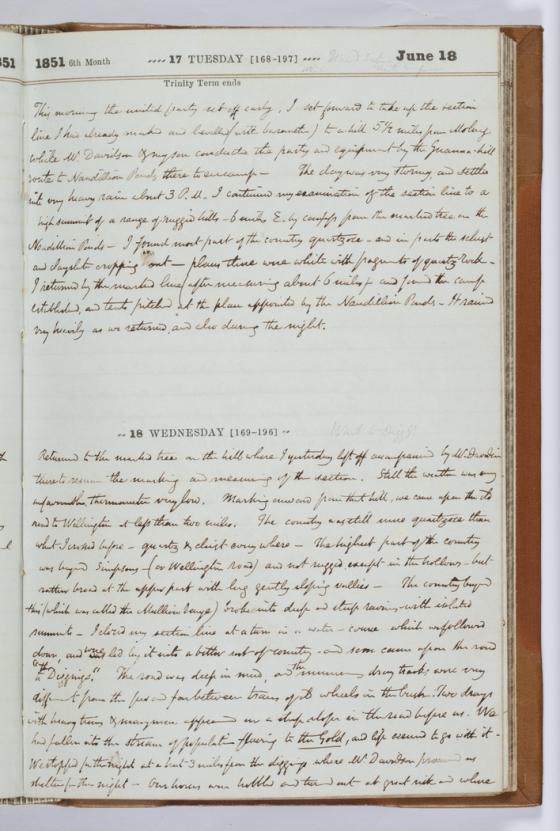
Sir Thomas Mitchell diary, with comments on the discovery of gold, especially in the Bathurst district p.4 1851
Tuesday, 17th June 1851
This morning the misted party set off early. I set forward to take up the section line I had already marked and levelled (with barometer) to a hill 5½ miles from Molong while Mr. Davidson & my son conducted the party and equipment by the Guanna hill route to Nandillion Ponds there to encamp. The day was very stormy and settled into very heavy rain about 3 P.M. I continued my examination of the section line to a high summit of a range of rugged hills – 6 miles E. by compass from the marked tree on the Nandillion Ponds. I found most part of the country quartzose – and in parts the schist and clayslate cropping out – places there were white with fragments of quartz rock. I returned by the marked line (after measuring about 6 miles) and found the camp established, and tents pitched at the place appointed by the Nandillion Ponds. It rained very heavily as we returned and also during the night.
Wednesday, 18th June 1851
Returned to the marked tree on the hill where I yesterday left off accompanied by Mr. Davidson there to resume the marking and measuring of the section. Still the weather was very unfavourable, thermometer very low. Marking onward from that hill, we came upon the old road to Wellington at less than two miles. The country was still more quartzose than what I crossed before – quartz & chist everywhere. The highest part of the country was beyond Simpsons (or Wellington road) and not rugged except in the hollows – but rather broad at the upper part with long gently sloping vallies. The country beyond this (which was called the Mullin Range) broke into deep and steep ravines with isolated summits. I closed my section line at a turn in a water-course which we followed down, and was were led by it into a better sort of country – and soon came upon the road to “the Diggings”. The road was deep in mud, and the miners dray tracks were very different from the person far between trains of its wheels in the bush. Two drays with heavy trains & many men appeared in a steep slope in the road before us. We had fallen into the stream of population flowing to the Gold, and life seemed to go with it. We stopped for the night at a hut 3 miles from the diggings where Mr. Davidson promised us shelter for the night. Our horses were hobbled and turned out at great risk and where